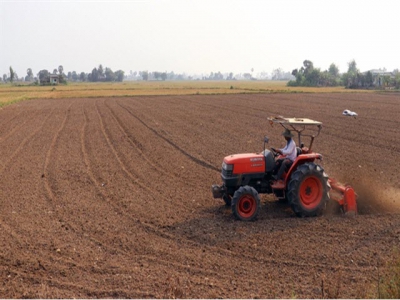Rice farmers in Mekong Delta told to follow sowing schedules as saline intrusion

Ho Chi Minh City — Authorities have instructed farmers in the Cửu Long (Mekong) Delta to sow the summer – autumn rice crop on established schedules to mitigate the damage of drought, saltwater intrusion and disease.
Preparing land for sowing the summer – autumn rice in Kiên Giang Province’s Giang Thành District. — VNA/VNS Photo Lê Huy Hải
The delta, the country’s rice granary, plans to grow about 1.6 million hectares of rice in the summer – autumn crop, according to the Ministry of Agriculture and Rural Development’s Plant Cultivation Department.
The delta is facing drought and severe saltwater intrusion which is expected to continue and only reduce after this month.
The Plant Cultivation Department has set schedules for sowing the crop in the delta between March and June.
In areas that can secure irrigation water, the sowing is in March and April, while sowing is set in May for areas located south of National Highway No 1 and 70km from the coast.
In areas that depend on rainwater for irrigation, sowing will be in the first half of June when rain is expected.
Based on the sowing schedules, the delta’s 12 provinces and Cần Thơ City have set up detailed sowing plans for each area.
In Kiên Giang Province, which is the delta’s largest rice producer, the province’s Department of Agriculture and Rural Development has given farmers detailed plans between March 20 and June 26.
The level of water resources in Kiên Giang’s upper areas has been low, so the province has operated sluices properly to prevent shortage of irrigation water and has dredged irrigation ditches to increase water storage.
Kiên Giang targets growing 284,000ha of rice with an average yield of 5.5 tonnes per hectare in the summer – autumn crop.
The province has instructed farmers to grow more high-quality rice varieties that meet export standards, aiming for 85 per cent.
In An Giang Province, farmers have been told to sow the crop between March 10 and May 20 to avoid irrigation water shortage and pests, mostly brown plant hoppers.
Nguyễn Sĩ Lâm, director of the An Giang Department of Agriculture and Rural Development, said farmers should follow schedules to avoid damage caused by brown plant hoppers.
Farmers should also apply integrated pest management and other techniques used in rice cultivation, he said.
In Sóc Trăng Province, authorities have told farmers to sow the crop between the end of April and June, and each area has to sow rice seeds at the same time to prevent the spread of brown plant hoppers.
Ngô Thanh Loan, deputy head of the Sóc Trăng Plant Cultivation and Protection Sub-department’s Plant Cultivation Division, said: “In areas affected by saltwater intrusion, farmers have to wash salts out of fields carefully before sowing rice seeds.”
When the price of rice rose recently, many farmers in the delta sowed the summer – autumn rice crop earlier compared to instructed schedules after they had a bumper harvest for the 2019-20 winter – spring rice crop.
Farmers had a bumper harvest because local authorities had instructed farmers to grow the crop one month earlier compared to normal schedules to avoid the impact of drought and saltwater intrusion.
However, the delta saw 33,800ha of its 1.54 million hectares of winter – spring crop damaged by drought and saltwater intrusion as many farmers did not follow the sowing schedule instructions.
Có thể bạn quan tâm
 Coffee industry to face more losses in Q2
Coffee industry to face more losses in Q2 Việt Nam's coffee industry will probably suffer more losses in the second quarter due to the novel coronavirus (COVID-19) pandemic
 Bình Phước cashew processors face shortage of capital, raw materials
Bình Phước cashew processors face shortage of capital, raw materials Bình Phước Province, known as the "capital of cashew" in the country, is facing problems processing cashews due to limited raw materials and capital.
 Viet Nam needs market of agricultural land
Viet Nam needs market of agricultural land The market for agricultural land is at an early stage of development, with many barriers in terms of land management and incentive policies.